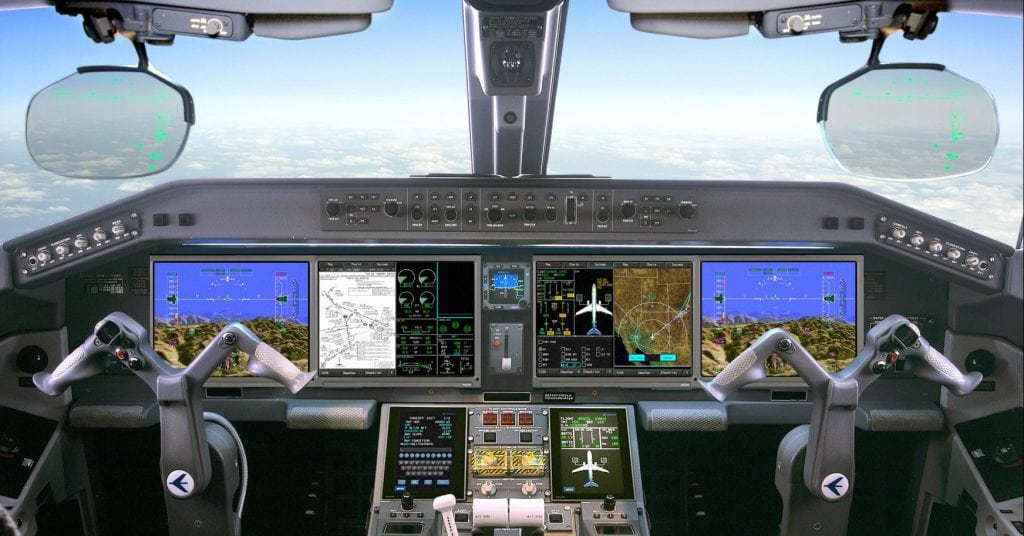Global Avionics Round-Up from Aircraft Value News (AVN)

Cockpit of an Embraer E-Jet with Head-Up Displays. (Image: Embraer)
As we approach the cusp of 2026, one of the most significant avionics trends set to reshape the cockpit isn’t artificial intelligence, it’s the evolution of Head-Up Displays (HUDs). Once a specialized feature for fighter jets and select business aircraft, HUD technology is now moving into commercial airliners and regional aircraft at scale.
Next-generation HUDs promise to improve safety, situational awareness, and operational efficiency while redefining the pilot experience.
At its core, a HUD projects critical flight information directly into the pilot’s line of sight. This allows pilots to maintain situational awareness without shifting focus to traditional cockpit instruments.
The benefits are clear: faster reaction times, reduced workload, and enhanced safety, particularly in challenging conditions such as low-visibility approaches, night operations, or congested airspace.
In 2026, HUDs are likely to continue their transition from simple symbology to fully integrated systems that overlay navigation, terrain, weather, and traffic data directly onto the outside view.
Advances in optical waveguide technology and high-resolution displays mean that HUDs can now deliver richer, brighter, and more dynamic visuals without obstructing the pilot’s natural view. HUDs are becoming the stuff of science fiction.
From Fighter Jets to Commercial Airliners
Historically, HUDs were primarily used in military aviation, where situational awareness in high-stakes environments is critical. Today, avionics manufacturers like Collins Aerospace, Elbit Systems, and Rockwell Collins are adapting these technologies for commercial and regional aircraft.
The trend is clear: major airlines and business jet operators are increasingly specifying HUDs as standard or optional equipment, rather than a niche luxury.
For instance, Boeing’s 737 MAX and Airbus’s A320neo families are now seeing HUD options for low-visibility operations and precision approaches. Regional jets, including Embraer E-Jets and Mitsubishi SpaceJets, are expected to adopt next-gen HUDs in 2026, providing smaller carriers with military-grade situational awareness at a commercial scale.
Safety and Operational Efficiency
One of the key drivers for HUD adoption is safety. Research consistently shows that pilots can execute complex maneuvers more accurately when critical information is projected in their forward field of view. HUDs reduce the need to shift attention between instruments and the outside environment, minimizing the risk of spatial disorientation.
Next-generation HUDs are expected in the coming years to be integrated with Enhanced Flight Vision Systems (EFVS) and Synthetic Vision Systems (SVS). EFVS uses infrared and other sensors to create a “see-through” effect in low-visibility conditions, while SVS generates a real-time 3D representation of terrain and obstacles.
When combined with HUDs, these systems allow pilots to land safely in fog, heavy rain, or darkness, conditions that previously required instrument-only procedures.
Operational efficiency is another benefit. HUDs can display optimal glide paths, real-time wind and weather data, and taxi routing, allowing airlines to reduce delays, save fuel, and minimize wear on engines and brakes.
For commercial operators, this translates directly into cost savings and more predictable schedules, two factors that influence lease rates and aircraft valuations.
HUD technology is increasingly seen as a value driver in the aircraft market. Aircraft equipped with next-generation HUDs are likely to command higher lease rates and residual values, particularly for fleets operating in challenging environments or on high-traffic routes.
Airlines are also exploring retrofits for mid-life aircraft, allowing operators to upgrade situational awareness and operational efficiency without replacing the entire fleet.
Next year is poised to mark a tipping point where HUDs transition from a specialized optional feature to a broadly adopted cockpit enhancement. Manufacturers that provide scalable, upgradeable HUD solutions stand to gain a competitive edge, as airlines seek to maximize both operational safety and asset value.
The Future of HUDs
Looking beyond 2026, HUD technology will continue to evolve. Eye-tracking integration, augmented reality overlays, and full-color 3D symbology are on the horizon, creating cockpits that are increasingly intuitive and immersive.
The ultimate goal is a cockpit where pilots can access all critical flight information without ever losing focus on the sky—a cockpit where situational awareness and operational efficiency are seamlessly fused.
For passengers, the benefits may not be immediately visible, but they are significant. Safer, more efficient operations reduce delays and improve reliability, while the ability to operate in a wider range of weather conditions expands route flexibility and network resilience.
By integrating advanced optics, enhanced flight vision, and synthetic overlays, HUDs are transforming the way pilots interact with the sky. This technology improves safety, enhances operational efficiency, and drives value in both new and existing fleets.
This article first appeared in Aircraft Value News.
John Persinos is the editor-in-chief of Aircraft Value News.